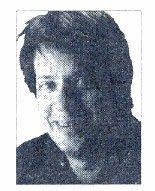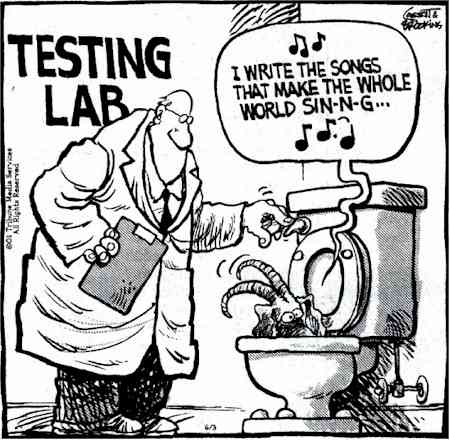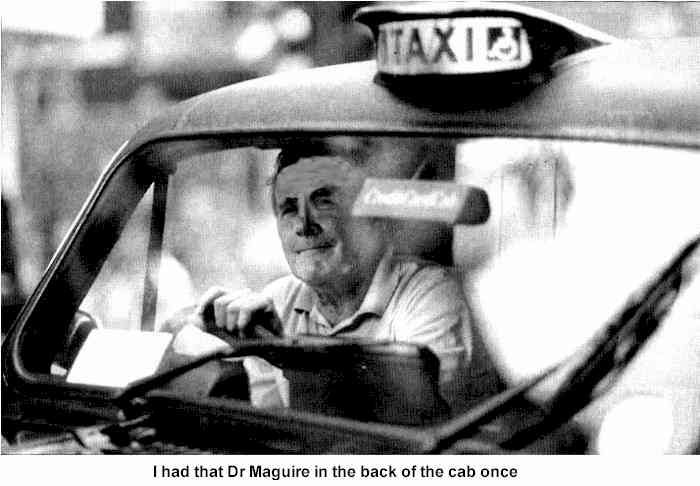Reuben, Reuben I've Been Thinking
Knowing and UnknowingTime Loop"For the first trial we'll only revert one minute," Potter said. Inside the time machine Barlow nodded. - by Tony Girling, Picton from The Future Is NowYesterday I travelled into the future. - Jason "Topsey" Turvey in Funny Times May 2001
Toilets Are Going Down the Drainby Dave Barry
Recently I watched as a professional engineer attempted to flush fermented bean curd down a toilet. This was not some fun engineer prank. This was a laboratory test conducted at the research center of the National Association of Home Builders, which is trying to develop a laboratory test for toilet performance that simulates the challenges faced by toilets in the real world. This research is necessary because Americans are unhappy with the wimpy toilets we are now required to buy. We yearn for the glory years, when our toilets were among the most powerful on earth - when the standard American household commode could, in a single flush, as proven in actual tests, suck down a mature sheep. (Before I get a lot of mail from angry animal rights activists, let me stress that those tests did not use an actual sheep. That would be barbaric! They used two goats tied together.) But then, in 1992, Congress - instead of passing a law that would actually benefit ordinary Americans, such as a mandatory death penalty for telemarketers - decided to cripple our toilets. Specifically, Congress passed a law limiting new toilets to 1.6 gallons of water per flush, less than half what the old toilets used. In terms of power and sturdliness, our toilets went from being the Baltimore Ravens to being Barry Manilow. (Before I get a lot of mail from angry Barry Manilow fans, let me stress that, as a musician and a performer, he sounds like two goats tied together.) The new toilets were supposed to save water. And they work okay when it comes to disposing of what is euphemistically referred to as "Number 1." The problem is that, when they must dispose of what is euphemistically referred to as "Geraldo," they tend to clog, and they often must be flushed repeatedly, which actually wastes water. (Before I get a lot of mail from angry Geraldo fans, let me stress that there are no Geraldo fans.) So anyway, the plumbing and home-building industries have gotten many complaints about the new toilets. That's why the National Association of Home Builders has been trying to come up with a real-world toilet test so we'll know which, if any, toilets actually work so consumers can buy these and get rid of the bad toilets, which will then be dropped from bombers onto the US Capitol. Okay, that last part is a fantasy (for now). But the NAHB really is doing serious toilet research, as I learned when I was given a tour of its Maryland research facility by Larry Zarker, Chuck Arnold and Tom Kenney. They showed me a laboratory where test toilets are mounted on a frame; the procedure is, you put your test material into the bowl, flush, then see how much material makes it through to a wire collection basket underneath. (Kids: This would be a great science fair project!) Kenney first showed me the current test standard, in which the toilet is supposed to flush 100 little plastic balls. There are two problems with this test. One is that anybody who emits anything like 100 little plastic balls doesn't need a better toilet; he needs immediate medical care. The other problem is that the test is way too easy. "Any toilet in the world can pass it," said Kenney. He then showed me some of the tougher, more realistic tests being considered. These involve various materials, including wads of paper and sponges, both weighted and unweighted, to simulate what the NAHB refers to as "sinkers" and "floaters." But the most impressive test material by far is the fermented bean curd, which Kenney said is made, using a secret recipe, by the Toto toilet company of Japan, a world leader in commode innovation. I mean, this stuff looks exactly like real Geraldo. I myself would not touch it. I watched in fascinated horror as Kenney boldly grasped a mass of it and, with his bare hands, formed 10 incredibly lifelike Puff Daddies. Needless to say, these clogged the test toilet. I was deeply moved by this experience. I came away convinced that these engineers will, some day, develop a test that will enable us, as a nation, to once again have faith in our commodes. When that day comes, I want to shake the hands of the courageous researchers who made it possible. But first they will have to wash up.
Dave Barry is a columnist for the Miami Herald. Source: The Sunday Star-Ledger 3 June 2001
I Have a Nonlinear ToiletHello all: I have noticed the strangest behaviour in the flush/refill cycle of my toilet, and I wanted to share it with all of you (besides, I couldn't find any newsgroups like alt.nonlinear or sci.nonlinear.strange.but.true). Most of the time, I flush the toilet and it refills and the valve shuts off the water flow like a regular toilet. From time to time, though, the toilet water flow starts to oscillate just before the tank fills up; I presume the water level over-shoots the cut off level, which causes the flapper valve to open in a partial flush. The process then starts again, and it seems as if the toilet never reaches equilibrium. I let it do this for 10 minutes yesterday, and I couldn't detect any dampening, and it seemed like a more-or-less constant period oscillation. I suspect that there are some nonlinearities in the toilet float/flapper valve dynamics similar to the Volterra-Lotka equation. Normally, the toilet operates on the stable manifold, fills up to the top and stops, but occasionally initial conditions are such that it oscillates about the fixed point. I sure hope that it never starts operating on the unstable manifold! This behaviour has led me to think about the toilet in a whole new light; there is at least one more degree of freedom in there than I would have thought. Anyway, I posted this to share a strange experience with all of you, and also to ask you to share your stories of any other "unexpected" household nonlinearities. Source: mwilliams1@comet.net posted this in the newsgroup sci.nonlinear
You, Only with a Better Brainby Don Saroff, Santa Monica, California As an orthopædic surgeon, I spend a good deal of time battling potentially deadly hip fractures and arthritis. The biggest battle, however, is trying to change people's behaviour after they incur small fractures that forecast larger, more dangerous ones. People keep their throw rugs and small pets to trip over, continue smoking, and remain inactive and overweight. If we were really built to last, the most important fix would be a brain with a sense of self-responsibility and an understanding of risks and benefits, a brain that actually listened when our parents told us not to stick our fingers in the fan. Source: Scientific American July 2001
Neuroscience: Taxicology
London taxi drivers pride themselves on their knowledge of their city's streets. So much so, indeed, that they spell the word with a capital "K". And well they might. For, unlike taxi drivers in most other cities around the world, they have to pass an exam to get their badges. The Knowledge - of where the streets in central London are, and of the quickest way from one to another - is the most important part of that exam. Such proven mastery of spatial information makes them ideal subjects for a study of how the brain learns to navigate. In the current edition of Proceedings of the National Academy of Science, Eleanor Maguire of University College London, and her colleagues have published the results of just such a study. Besides confirming where in the brain navigational skills are stored, this research is the first to show how an adult, human brain can remodel its basic anatomy in response to the needs of its owner. Deep inside each half of the brain lies a structure called the hippocampus. It is, in evolutionary terms, one of the oldest parts of the vertebrate brain, and neurologists have known for a long time that it plays a critical role in the formation of memories. But a combination of studies, some of people with damaged hippocampi, and others of healthy individuals whose hippocampi have been examined by brain-scanning, has shown that it is particularly involved in learning how to navigate, and that this skill is concentrated in the back of the structure. Since London taxi drivers are navigators par excellence, Dr Maguire and her colleagues decided to examine their hippocampi to see if they differed from those of ordinary Londoners who do not necessarily know the best way to get to Bermondsey by way of Bethnal Green. The technique they used is called magnetic-resonance imaging. It works by stimulating hydrogen atoms to give off a radio signal. Since different sorts of living tissue contain different amounts of hydrogen, the application of sufficient computing power to the signal can turn it into a clear image of the body's interior. The first task was to establish that it was indeed the hippocampus in which changes were taking place. To do this, Dr Maguire needed a "reference" brain to act as a standard. All brains differ slightly; big people, for example, tend to have big brains. So she constructed her reference by averaging the scans from 50 right-handed men (since the drivers in her sample were all male and dexterous). That established an average size and shape for the whole brain. Then she compared the brains of her drivers with those of "ordinary" folk (again, a group of right-handed men). In each case, the image produced was transformed so that its overall size and shape matched the standardised reference brain. That enabled her to compare the components of the brains of the two groups. She looked for differences in all of the brain's main components, but the only ones she could find were in the hippocampi. In taxi drivers, the back of the hippocampus was larger than it was in average men. A more detailed study that focused directly on the hippocampus showed that the front was smaller in taxi drivers, too. The second task was to find out whether having an unusual hippocampus makes you more likely to become a taxi driver, or whether becoming a taxi driver causes your hippocampus to become unusual. To answer that question, Dr Maguire plotted the differences in the size of the structure against the amount of time that an individual had been driving a cab. She found that taxi drivers' hippocampi do, indeed, become more unusual with time: their back parts grow and their front parts shrink. That is an important result, for it shows that adult brains are more plastic than conventional neurological wisdom had supposed. But it also suggests that the back of the hippocampus is growing at the expense of the front. This raises the possibility that cab drivers are paying to acquire the Knowledge in some as yet unknown way. Whether the loss of frontal tissue has any relationship with the robust political opinions for which London cabbies are renowned is an area that remains mercifully uninvestigated. Source: The Economist "Science and Technology" section 18 March 2000
I read in a science journal of brain scans done on monkeys who had had various limbs removed. When a part of the brain was no longer needed to move the right forearm, say, that part appeared to be incorporated into a neighbouring area. I take this to mean that physically handicapped people are probably more intelligent than average because they have more spare parts mentally. Those employers with foresight enough to hire them get a real bargain. I lost my right eye at a very early age. My parents were lower-middle class - my father drove a truck and my mother was a clerk. I won two scholarships including a National Merit Scholarship and was selected as a Presidential Scholar. I have returned to university in middle age and have maintained a 4.0 average. I believe these events may all be related.
Collecting CitationsDate: Friday 29 Aug 1997 Dear Fellow Scientist: This letter has been around the world at least seven times. It has been to many major conferences. Now it has come to you. It will bring you good fortune. This is true even if you don't believe it. But you must follow these instructions: include in your next journal article the citations below. Remove the first citation from the list and add a citation to your journal article at the bottom. Make ten copies and send them to colleagues. Within one year, you will be cited up to 10,000 times! This will amaze your fellow faculty, assure your promotion and improve your sex life. In addition, you will bring joy to many colleagues. Do not break the reference loop, but send this letter on today! Dr H received this letter and within a year after passing it on she was elected to the National Academy of Sciences. Prof M threw this letter away and was denied tenure. In Japan, Dr I received this letter and put it aside. His article for Transactions on Nephrology was rejected. He found the letter and passed it on, and his article was published that year in the New England Journal of Medicine. In the Midwest, Prof K failed to pass on the letter, and in a budget cutback his entire department was eliminated. This could happen to you if you break the chain of citations.
Source: psych.upenn.edu
For articles related to working including why, which career, bosses, time constraints, focus, trends, gender issues, pay differentials, getting laid off, getting re-hired, dependents, part-time work
and balancing work and values click the "Up" button below to take you to the Index page for this section on Working. |
 Animals
Animals Animation
Animation Art of Playing Cards
Art of Playing Cards Drugs
Drugs Education
Education Environment
Environment Flying
Flying History
History Humour
Humour Immigration
Immigration Info/Tech
Info/Tech Intellectual/Entertaining
Intellectual/Entertaining Lifestyles
Lifestyles Men
Men Money/Politics/Law
Money/Politics/Law New Jersey
New Jersey Odds and Oddities
Odds and Oddities Older & Under
Older & Under Photography
Photography Prisons
Prisons Relationships
Relationships Science
Science Social/Cultural
Social/Cultural Terrorism
Terrorism Wellington
Wellington Working
Working Zero Return Investment
Zero Return Investment Tastefulness advisory: Do not read this column if you are eating or plan to eat ever again. Thank you.
Tastefulness advisory: Do not read this column if you are eating or plan to eat ever again. Thank you.
